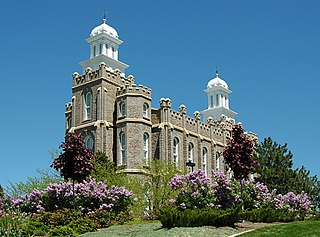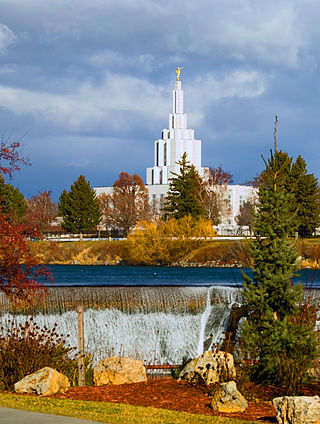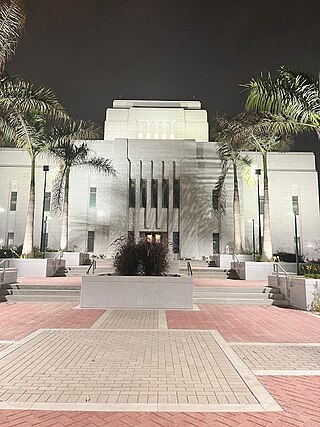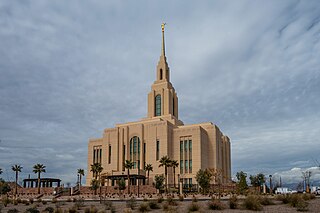
The Mesa Arizona Temple is the seventh operating temple of the Church of Jesus Christ of Latter-day Saints. The intent to build the temple was announced on October 1, 1919, by church president Heber J. Grant, during the church's general conference. Located in the city of Mesa, Arizona, as of April 2024, it is the first of the church's seven temples built or planned in the state, with three of those in Maricopa County. A groundbreaking ceremony was held on April 25, 1922, and the dedication, conducted by Grant, was on October 23, 1927.

The St. George Utah Temple, formerly known as the St. George Temple, is a temple of the Church of Jesus Christ of Latter-day Saints in St. George, Utah. Completed in 1877, it was the third temple constructed by the church and the first in Utah, following the westward migration of members from Nauvoo, Illinois, after the death of church founder Joseph Smith.

The Logan Utah Temple was completed in 1884, and is the fourth temple built by the Church of Jesus Christ of Latter-day Saints. Located in the city of Logan, Utah, it was the second temple completed in Utah, after the St. George Temple. It was built on a 9-acre (3.6 ha) plot selected by church president Brigham Young.

The Cardston Alberta Temple is a temple of the Church of Jesus Christ of Latter-day Saints in Cardston, Alberta. It was the eighth temple constructed and is the sixth still in operation. The intent to build the temple was announced on October 12, 1912, by church president Joseph F. Smith, during the church's general conference. It was both the first temple built in Canada and outside the United States. There are four temples in the province of Alberta and ten operated by the church in Canada.

The Idaho Falls Idaho Temple is a temple of the Church of Jesus Christ of Latter-day Saints in Idaho Falls, Idaho. The intent to build the temple was announced on March 3, 1937, by church president Heber J. Grant during the church's general conference. It is the church's tenth constructed and eighth operating temple, the first built in Idaho, and the first built with a modern single-spire design.

The Hamilton New Zealand Temple is the 13th constructed and 11th operating temple of the Church of Jesus Christ of Latter-day Saints. The intent to build the temple was announced on February 17, 1955, by church president David O. McKay during a meeting of the First Presidency and Quorum of the Twelve Apostles. With its completion in 1958, it was the church's first temple in the Southern Hemisphere, the second built both in Polynesia and outside the United States and Canada, after the Laie Hawaii Temple. Located just outside Temple View in Hamilton, it was built with a modern single-spire design similar to the Bern Switzerland Temple. As of May 2024, this is the only temple currently operating in New Zealand, with one in Auckland under construction, and another in Wellington in the planning phase.

The Washington D.C. Temple is the 18th constructed and 16th operating temple of the Church of Jesus Christ of Latter-day Saints. It is located in Kensington, Maryland, United States, just north of Washington, D.C., near the Capital Beltway. The intent to build the temple was announced on November 15, 1968, by church president David O. McKay. A groundbreaking ceremony was held on December 7, 1968, with the dedication by Spencer W. Kimball on November 9, 1974. The temple was dedicated after an open house that attracted over 750,000 people. The temple was the first built by the church east of the Mississippi River since 1846, when the original Nauvoo Temple was dedicated.

The Provo Utah Temple was a temple of the Church of Jesus Christ of Latter-day Saints located in Provo, Utah, just north of Brigham Young University (BYU). The intent to build the temple was announced on August 14, 1967, by Hugh B. Brown and N. Eldon Tanner. The church's temples are a sacred space where church members make covenants and perform ordinances for themselves and their deceased ancestors. The temple was designed by architect Emil B. Fetzer and was dedicated in 1972 as the church's seventeenth constructed and fifteenth operating temple. It was the sixth temple built in Utah, and the first in both Utah County and Provo.

The Portland Oregon Temple is a temple of the Church of Jesus Christ of Latter-day Saints located on 7 acres (28,000 m2) of land near the intersection of Highway 217 and I-5 in Lake Oswego, Oregon. The intent to build the temple was announced on April 7, 1984 by church president Spencer W. Kimball, during the church's general conference. Dedicated in 1989, the Portland Oregon Temple was the church's first temple in Oregon and the 42nd in the church. Prior to its dedication by Gordon B. Hinckley, over 314,000 people attended the public open house.
Below is a chronological list of temples of the Church of Jesus Christ of Latter-day Saints with sortable columns. In the LDS Church, a temple is a building dedicated to be a House of the Lord and considered by church members to be the most sacred structures on earth. Upon completion, temples are usually open to the public for a short period of time, and then each is dedicated as a "House of the Lord," after which only members with a current temple recommend are permitted to enter. Thus, they are not churches or meetinghouses, but rather specialized places of worship. The LDS Church has 350 temples in various phases, which includes 191 dedicated temples, 50 under construction, and 109 others announced. Within temples, members of the LDS Church make covenants, receive instructions, and perform rituals and ordinances. Additionally, members consider the temple a place to commune with God, seek God's aid, understand God's will, and receive personal revelation.

The Oquirrh Mountain Utah Temple is a temple of the Church of Jesus Christ of Latter-day Saints located in South Jordan, Utah, a suburb of Salt Lake City. South Jordan was the first city in the world to have two temples. The temple was the fourth in the Salt Lake Valley and the 13th in the state of Utah.
The Urdaneta Philippines Temple is temple of the Church of Jesus Christ of Latter-day Saints in Urdaneta City, Pangasinan, Philippines. The intent to build the temple was announced on October 2, 2010, by church president Thomas S. Monson, during the church's general conference. The temple is the third in the Philippines, following those in Manila and Cebu City.

The Lima Peru Los Olivos Temple is a temple of the Church of Jesus Christ of Latter-day Saints in the San Martin de Porres district, Lima, Peru. The temple was dedicated by D. Todd Christofferson of the Quorum of the Twelve Apostles on January 14, 2024.

The Layton Utah Temple is a temple of the Church of Jesus Christ of Latter-day Saints under construction in Layton, Utah. The intent to construct the temple was announced by church president Russell M. Nelson on April 1, 2018, during the 188th general conference. The Layton Utah Temple was announced concurrently with 6 other temples. At the time, the number of total operating or announced temples was 189. It is the 22nd temple in Utah and the second temple in Davis County.
The Yigo Guam Temple is a temple of the Church of Jesus Christ of Latter-day Saints in Yigo, Guam.

The Orem Utah Temple is a temple of the Church of Jesus Christ of Latter-day Saints located in Orem, Utah. The intent to build the temple was announced on October 5, 2019, by church president Russell M. Nelson, during the church's general conference. The temple is the first in the city of Orem, the sixth in Utah County, and the 28th in the state of Utah.

The Taylorsville Utah Temple is a temple awaiting dedication of the Church of Jesus Christ of Latter-day Saints in Taylorsville, Utah. Plans to construct the temple were announced on October 5, 2019 by church president Russell M. Nelson, during the church's general conference. The temple is the first in the city of Taylorsville, the fifth in Salt Lake County, and the twenty-third in the state of Utah.

The Red Cliffs Utah Temple, originally announced as the Washington County Utah Temple, is a temple of the Church of Jesus Christ of Latter-day Saints in St. George, Utah. The intent to construct the temple was announced in October 2018 by church president Russell M. Nelson. It is the second temple in Washington County, with the St. George Utah Temple being the first, and the fourth in southern Utah.
The Cobán Guatemala Temple is a temple of the Church of Jesus Christ of Latter-day Saints that is being built in Cobán's 2nd ward. It will be Guatemala's third temple, with the two other ones being the Guatemala City Guatemala and Quetzaltenango Guatemala temples.





















